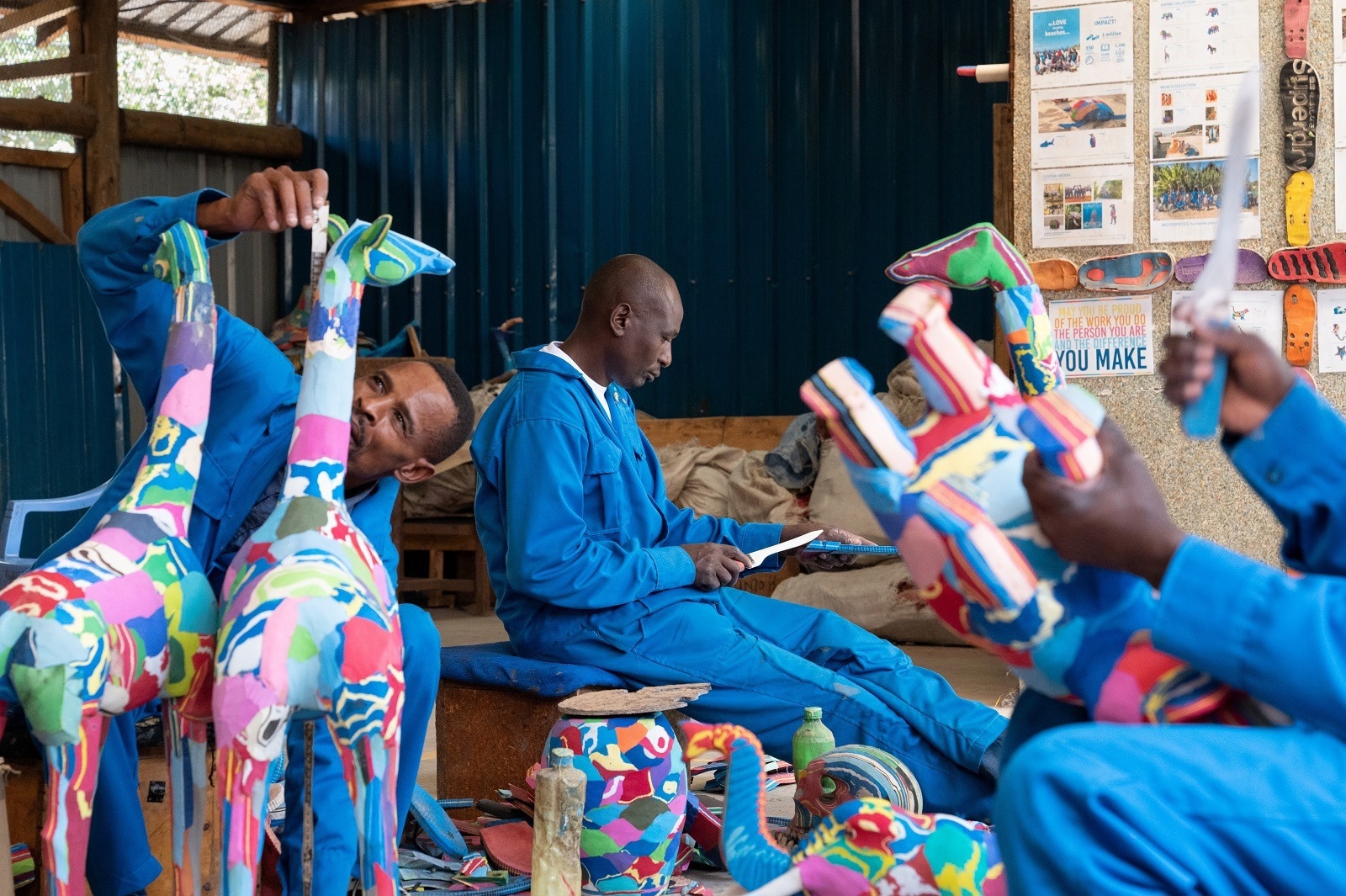A new book published by Australia’s national science agency, CSIRO, shines a light on the creative and impactful ways communities across the globe are dealing with the plastic pollution crisis.
 Ocean Sole artists at work. Image Credit: CSIRO
Ocean Sole artists at work. Image Credit: CSIRO
Released today, Ending Plastic Waste: Community Actions Around the World presents a collection of stories, advice and information from people in the field, and aims to serve as a source of inspiration to reduce plastic waste in the environment.
The book highlights 19 initiatives from 15 countries including Australia – including reusable menstrual products, thongs into artworks, and a recycling app to prevent waste ending up in landfill.
It’s estimated that global plastic production will double by 2040, and there are trillions of pieces of plastic already in our oceans.
CSIRO scientist and editor, Dr Denise Hardesty, said such is the scale of the problem that in June this year, countries from around the world came together to continue negotiations for the United Nations Environmental Programme global treaty to end plastic pollution.
“Plastic pollution is now considered a planetary crisis. The world is taking notice that we need to change our relationship with plastic and use plastic as a resource, rather than a waste,” Dr Hardesty said.
“It’s heartening to see how communities are managing plastic pollution in their local environment, delivering wins for the environment, the economy and livelihoods. We can all make a difference,” she said.
Ocean Sole: Upcycling Thong Pollution (Kenya)
In Kenya, one million thongs are found as litter along its coastline per year. Ocean Sole is turning the discarded thongs into artworks.
Joe Mwakiremba from Ocean Sole said the organisation had recovered and upcycled over 559 tonnes of thong pollution since it began in 2006, using them to produce 65,000 artworks.
“The issue was so bad that turtles could no longer use some beaches to nest and lay eggs. Now, we have 15 coastal communities collecting thongs, resulting in economic benefits and cleaner beaches,” Joe Mwakiremba said.
Plastics Circle: Circular Economy for Plastics (Australia/India)
Another program is the Plastics Circle. Founder Murray Hyde said the organisation has created an app to connect businesses to specific post-consumer recycled (PCR) plastic.
“Quality recyclables were going to waste in countries across Asia. The app creates a circular economy model so plastic can be used again, rather than going to landfill or ending up in our oceans,” Mr Hyde said.
“The app creates a market for PCR plastics with information on the plastic type, colour, condition, location and price so it can be used again,” he said.
The Plastics Circle was trialled in India, recovering almost 4000 kg of plastic over 67 collection days, equating. to almost six kilograms per person per day.
Natalie Harms is the Programme Officer on Marine Litter, Secretariat of the Coordinating Body on the Seas of East Asia (COBSEA), United Nations Environment Programme (UNEP).
“Armed with knowledge and the stories told in this book, readers will feel inspired and empowered to create their own organisation and join us in our collective effort towards solving the global plastics pollution challenges.” Ms Harms said.
Ending Plastic Waste: Community Actions Around the World is available now.
CSIRO is on a mission to end plastic waste, with a goal of an 80 per cent reduction in plastic waste entering the Australian environment by 2030.
Case Studies Highlighted in the Book:
Plastic Collective – Australia
- The Plastic Collective is a social enterprise to educate and equip remote communities with facilities to turn plastic waste into a resource.
- Founder Louise Hardman has seen the impact of plastic firsthand. Rescuing a stranded turtle with a gut full of plastic inspired Louise to establish Resource Recovery Stations in communities to turn plastic into sellable recyclable material using a Shruder, which shreds plastic waste.
- Each station has a target to recycle 200 tonnes of material per year. This provides economic, environmental, and societal benefits. It empowers communities with knowledge, particularly those with poor infrastructure, and high transport costs to manage waste.
- Many of the resource recovery stations are currently operating across the Australian and South-East Asia region.
Mamma’s Laef - Vanuatu
- When a cyclone hit Vanuatu and supplies were cut off, Belinda Roselli pondered how women could manage through menstruation. This inspired Mamma’s Laef.
- The organisation creates reusable hygiene products for women, offering a dignified and plastic free solution.
- Local women manufacture reusable menstrual pads, incontinence aids and baby nappies. These are distributed to the local community across the island.
The Plastics Circle – Australia/India
- The Plastics Circle has created an app where brands and plastic processors can place orders for specific post-consumer recycled (PCR) plastic.
- Quality recyclables were going to waste in countries across Asia. The app creates a plastics circular economy model so plastic can be used again, rather than going to landfill or ending up in our oceans.
- The app shares information on the plastic type, colour, condition, location and price.
- The commercial model has been piloted with success in India. Ten collectors recovered almost 4000 kg of plastic over 67 collection days – almost 6 kg per person per day.
Ocean Sole - Kenya
- One million thongs found as litter on Kenyan beaches per year have been turned into artworks through Ocean Sole.
- Ocean Sole has recovered and upcycled over 559 tonnes of thong pollution since it began in 2006, with a record-breaking 65,000 artworks created.
- Beaches in Kenya were littered with thongs. The issue had become so bad that turtles could no longer make nests on some beaches to lay their eggs.
- 15 coastal communities collect thongs. Ocean Sole then transforms the thong litter into collectable artwork, resulting in a thriving business, cleaner beaches, economic benefits and ocean conservation.
- Ocean Sole is looking to scale the program to other countries, such as Brazil.